Westtoer - Build your own Flanders pilgrimage
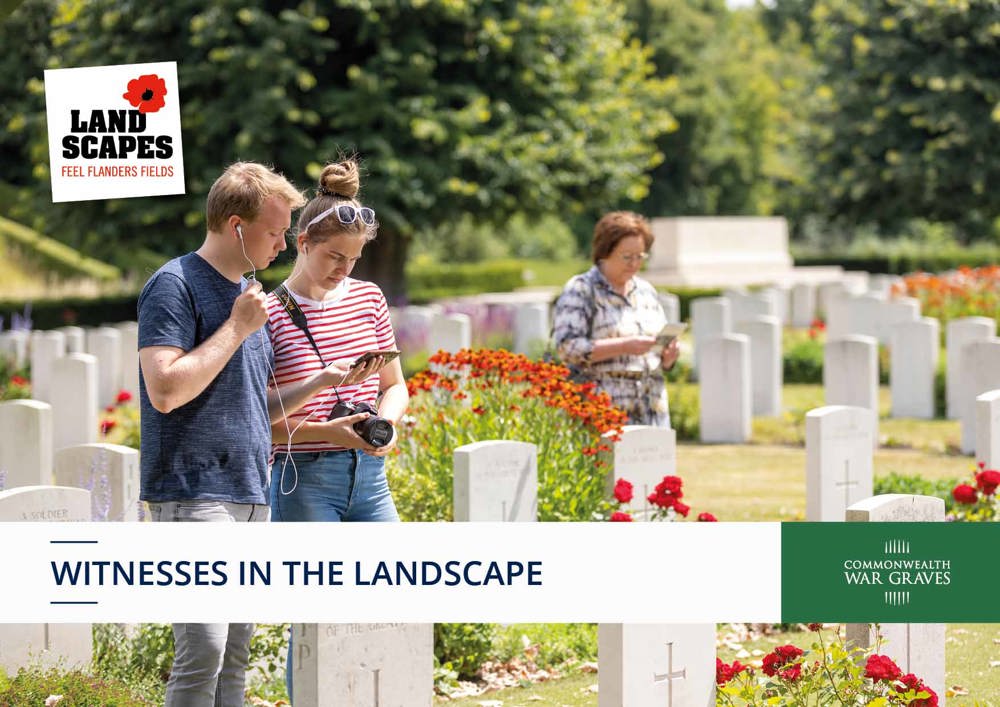
The long years of the First World War transformed the city of Ypres (today Ieper) and the surrounding countryside. The landscape was torn apart, and the buildings and woods smashed as far as the eye could see. Millions of men and women from across the world who came here to fight would never forget what they saw, felt, did and lost in Flanders Fields.
Today, time has healed the destruction. Despite this, people still journey to see this landscape that will be forever touched by violence and loss.
Wherever people go they will see the iconic green signs that point the way to the cemeteries of the Commonwealth War Graves Commission. Here can be seen the stark reality, the true human cost of war. These war cemeteries are so much more that simply rows upon rows of silent stones. Each is a witness, a fixed point in an ever-changing landscape.
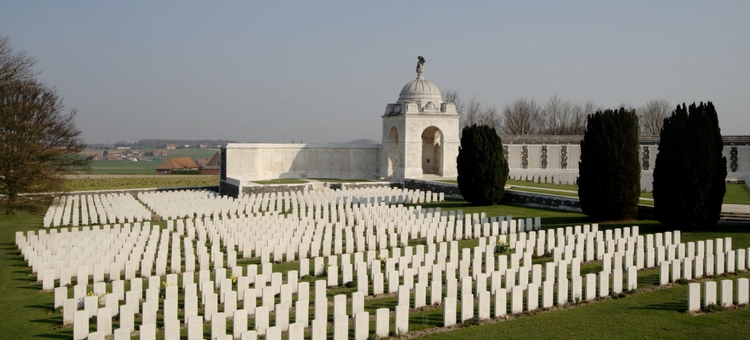
Suggested Tours
MUST SEE YPRES SALIENT TOURS
Not sure where to go and what to see? Follow this highly recommended half day tour and discover our recommended must-see cemeteries and memorials in the Ypres Salient.
Must See
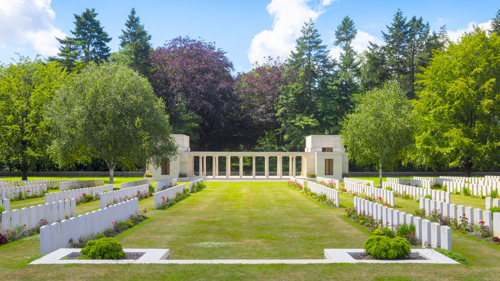
BUTTES NEW BRITISH CEMETERY & N.Z. MEMORIAL, AND POLYGON WOOD CEMETERY
Everyone who visits the old Ypres Salient should visit Polygon Wood. The wood, a key landmark during the First World War, was taken and held by the Australians at terrible cost in September 1917. Today, two distinctive cemeteries, a memorial to the missing, and a divisional memorial are located here amongst the regrown trees. Polygon Wood Cemetery is small and intimate, made during the war, while Buttes New British Cemetery is large and dramatic, created after the 1918 armistice when the shattered wood and surrounding area were carefully searched for the dead. Few of the graves in Buttes New British Cemetery are identified but many bear the distinctive ‘rising sun’ cap badge of Australian forces. Don’t forget to visit the New Zealand Memorial to the Missing on the far side of the cemetery.

ESSEX FARM CEMETERY
Essex Farm is one of the most visited CWGC cemeteries in the world. It was near here that a Canadian army medical doctor named John McCrae penned ‘In Flanders Fields’, a poem that has become synonymous with remembrance. This cemetery was begun by a medical unit that was established here in 1915. Over the next two years the medical facilities near Essex Farm were part of several key evacuation routes for the wounded. An Advanced Dressing Station was based in the bunkers beside the cemetery and in several wooden huts. Thousands of wounded soldiers were treated and those who succumbed to their wounds were laid to rest in what is now Essex Farm Cemetery. By the 1918 Armistice over 1,200 burials had been made.

TYNE COT CEMETERY AND MEMORIAL
After the end of World War 1 the area around Tyne Cot was a wasteland of shell holes as far as the eye could see. Almost nothing remained of the nearby village of Zonnebeke, while Passchendaele village had been obliterated entirely. Tens of thousands of soldiers had died in this small corner of the Ypres Salient. Tyne Cot’s central location near where the fighting had been heaviest made it an ideal site for a large cemetery to be create. By the end of 1921, 11,871 men had been buried, making Tyne Cot the largest CWGC cemetery anywhere in the world. The layout plan for the burials was made in 1919 by John Truelove, who served in France with the London Regiment until he was wounded in action in 1915. After the Commission took over responsibility for Tyne Cot in 1921, plans for the transformation of the cemetery were begun by Truelove and Sir Herbert Baker, one of the Commissions principal architects.
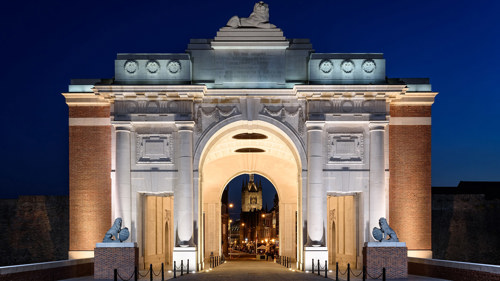
YPRES (MENIN GATE) MEMORIAL TO THE MISSING
Being the most recognizable memorial in the Ypres Salient, and regarded one of the largest memorials to the missing in the world, the Ypres Memorial to the Missing, or most commonly known as the Menin Gate, has stood for almost 100 years on the place where thousands of Commonwealth servicemen marched out of the city towards the Flanders battlefields.
LANDSCAPE - YPRES BATTLEFIELD TOURS
Do you want to see the scars of battle that still remain in the Ypres Salient? Follow this half day tour and discover some of the last remaining original battlefield features in the salient and how our cemeteries and memorials were shaped by the war.
Must See

BEDFORD HOUSE CEMETERY
This cemetery is widely regarded as one of the most beautiful in the old Ypres Salient. The graves here are divided into five distinct areas, or enclosures, each with a unique layout. This unusual cemetery occupies the grounds of a chateau which was used by the British during the First World War, with headquarters and medical facilities based here. Over time the chateau was destroyed by shelling while the groups of graves grew ever larger. After the 1918 armistice many additional burials were made, making this one of the largest CWGC sites in the Ieper area.

BUTTES NEW BRITISH CEMETERY & N.Z. MEMORIAL, AND POLYGON WOOD CEMETERY
Everyone who visits the old Ypres Salient should visit Polygon Wood. The wood, a key landmark during the First World War, was taken and held by the Australians at terrible cost in September 1917. Today, two distinctive cemeteries, a memorial to the missing, and a divisional memorial are located here amongst the regrown trees. Polygon Wood Cemetery is small and intimate, made during the war, while Buttes New British Cemetery is large and dramatic, created after the 1918 armistice when the shattered wood and surrounding area were carefully searched for the dead. Few of the graves in Buttes New British Cemetery are identified but many bear the distinctive ‘rising sun’ cap badge of Australian forces. Don’t forget to visit the New Zealand Memorial to the Missing on the far side of the cemetery.

HOOGE CRATER CEMETERY
Located beside the infamous Menin Road, when you arrive the true scale of this cemetery is hidden from view. The reveal is perhaps one of the greatest and most heart-breaking views in any CWGC cemetery. The fighting here was almost continuous through the First World War and by its end this was a landscape of overlapping shell holes and shattered tree stumps. Some 70 rough wooden crosses marked a small war-time burial ground. In the years after the 1918 Armistice, thousands of servicemen who were recovered from the surrounding battlefields were laid to rest here.

TYNE COT CEMETERY AND MEMORIAL
After the end of World War 1 the area around Tyne Cot was a wasteland of shell holes as far as the eye could see. Almost nothing remained of the nearby village of Zonnebeke, while Passchendaele village had been obliterated entirely. Tens of thousands of soldiers had died in this small corner of the Ypres Salient. Tyne Cot’s central location near where the fighting had been heaviest made it an ideal site for a large cemetery to be create. By the end of 1921, 11,871 men had been buried, making Tyne Cot the largest CWGC cemetery anywhere in the world. The layout plan for the burials was made in 1919 by John Truelove, who served in France with the London Regiment until he was wounded in action in 1915. After the Commission took over responsibility for Tyne Cot in 1921, plans for the transformation of the cemetery were begun by Truelove and Sir Herbert Baker, one of the Commissions principal architects.
PASSCHENDAELE TOURS, THE 3RD YPRES OFFENSIVE
They called it Passchendaele. Follow this half day tour and discover the greatest battle fought at Ypres during the First World War.
Must See

BUTTES NEW BRITISH CEMETERY & N.Z. MEMORIAL, AND POLYGON WOOD CEMETERY
Everyone who visits the old Ypres Salient should visit Polygon Wood. The wood, a key landmark during the First World War, was taken and held by the Australians at terrible cost in September 1917. Today, two distinctive cemeteries, a memorial to the missing, and a divisional memorial are located here amongst the regrown trees. Polygon Wood Cemetery is small and intimate, made during the war, while Buttes New British Cemetery is large and dramatic, created after the 1918 armistice when the shattered wood and surrounding area were carefully searched for the dead. Few of the graves in Buttes New British Cemetery are identified but many bear the distinctive ‘rising sun’ cap badge of Australian forces. Don’t forget to visit the New Zealand Memorial to the Missing on the far side of the cemetery.
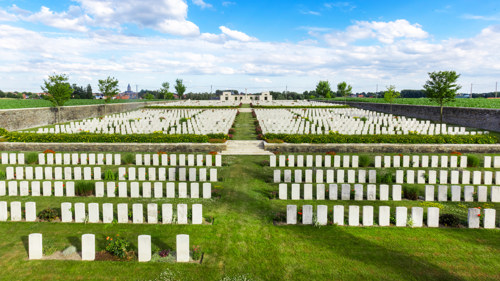
PASSCHENDAELE NEW BRITISH CEMETERY
There are many ghosts on this part of the battlefield. Those who died were often lost forever in the mud. After the war the area was carefully searched, and this cemetery was begun. You will find many Canadians here, their headstones engraved with the Maple Leaf badge. The cemetery itself was designed by Charles Holden and Wilfred Von Berg. The imposing entrance building is reminiscent of the German block houses which were desperately fought over in this landscape. Inside there are three carefully stepped levels which integrate the cemetery into the gently falling landscape.

PERTH CEMETERY (CHINA WALL)
Located close to the front for most of the war, the cemetery was actually begun by the French Army in 1914. Burials continued to be made here by British and Commonwealth forces in what is today Plot 1, towards the rear of the cemetery, until late October 1917. The story of this place is bigger than the war-time burials, however: post-war re-burials came here from no less than 30 cemeteries, each with its own story to tell.

TYNE COT CEMETERY AND MEMORIAL
After the end of World War 1 the area around Tyne Cot was a wasteland of shell holes as far as the eye could see. Almost nothing remained of the nearby village of Zonnebeke, while Passchendaele village had been obliterated entirely. Tens of thousands of soldiers had died in this small corner of the Ypres Salient. Tyne Cot’s central location near where the fighting had been heaviest made it an ideal site for a large cemetery to be create. By the end of 1921, 11,871 men had been buried, making Tyne Cot the largest CWGC cemetery anywhere in the world. The layout plan for the burials was made in 1919 by John Truelove, who served in France with the London Regiment until he was wounded in action in 1915. After the Commission took over responsibility for Tyne Cot in 1921, plans for the transformation of the cemetery were begun by Truelove and Sir Herbert Baker, one of the Commissions principal architects.
ALL SITES
Must See
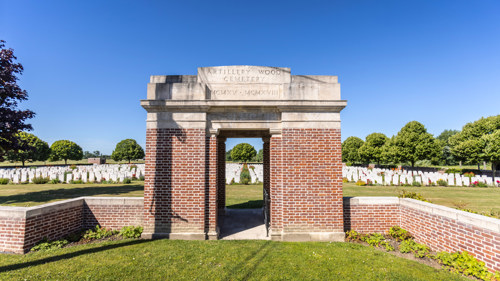
ARTILLERY WOOD CEMETERY
Names are so important for helping us to understanding the landscape of the First World War. What was here then is often not here now, but the old places live on in many of the names given to the cemeteries by the soldiers themselves. A wood that was once in the fields behind today’s cemetery hid the guns of the Royal Artillery from sight, earning the name ‘Artillery Wood’. Although the wood is gone, the name remains thanks to the cemetery, as a reminder of what was here more than 100 years ago. The ground where the cemetery stands was captured in 1917 and burials begun. 141 men were laid to rest here in the months that followed in what is today Plot 1. After the 1918 armistice the shell-torn battlefields nearby were searched and over 1,100 additional burials were made here.

BEDFORD HOUSE CEMETERY
This cemetery is widely regarded as one of the most beautiful in the old Ypres Salient. The graves here are divided into five distinct areas, or enclosures, each with a unique layout. This unusual cemetery occupies the grounds of a chateau which was used by the British during the First World War, with headquarters and medical facilities based here. Over time the chateau was destroyed by shelling while the groups of graves grew ever larger. After the 1918 armistice many additional burials were made, making this one of the largest CWGC sites in the Ieper area.

BUTTES NEW BRITISH CEMETERY & N.Z. MEMORIAL, AND POLYGON WOOD CEMETERY
Everyone who visits the old Ypres Salient should visit Polygon Wood. The wood, a key landmark during the First World War, was taken and held by the Australians at terrible cost in September 1917. Today, two distinctive cemeteries, a memorial to the missing, and a divisional memorial are located here amongst the regrown trees. Polygon Wood Cemetery is small and intimate, made during the war, while Buttes New British Cemetery is large and dramatic, created after the 1918 armistice when the shattered wood and surrounding area were carefully searched for the dead. Few of the graves in Buttes New British Cemetery are identified but many bear the distinctive ‘rising sun’ cap badge of Australian forces. Don’t forget to visit the New Zealand Memorial to the Missing on the far side of the cemetery.
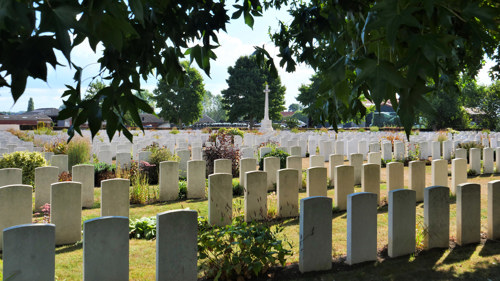
CEMENT HOUSE CEMETERY
To protect themselves from the storm of steel that rained down in the Salient day and night, both sides built hundreds of concrete bunkers around Ypres. One constructed inside an abandoned farm building just to the east of this cemetery became known as Cement House. It’s still there today. In August 1917, a cemetery was begun here in the wasteland of overlapping shell holes and smashed buildings, and some 200 men were laid to rest by their comrades in what is today Plot 1. After the 1918 Armistice, thousands of additional burials were made here, most of them men who died in the Autumn of 1917.
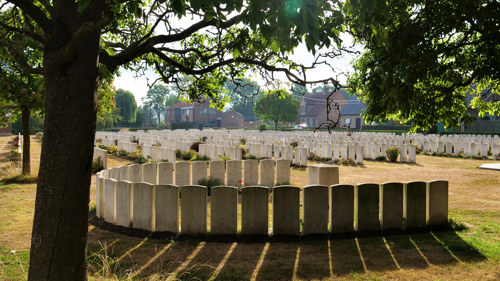
DUHALLOW A.D.S. CEMETERY
Duhallow A.D.S Cemetery is one of the many burial grounds created by medical units in the Ypres Salient. This one was begun on the first day of the Third Ypres Offensive in July 1917 by the 39th Division. As the fighting raged on, thousands of men were treated here and those who succumbed to their wounds were laid to rest. After the 1918 Armistice, plots 7, 8 and 9 were created, and additional burials of isolated graves and from several small cemeteries were made here. The cemetery was designed by Sir Reginald Blomfield and Noel Rew.

ESSEX FARM CEMETERY
Essex Farm is one of the most visited CWGC cemeteries in the world. It was near here that a Canadian army medical doctor named John McCrae penned ‘In Flanders Fields’, a poem that has become synonymous with remembrance. This cemetery was begun by a medical unit that was established here in 1915. Over the next two years the medical facilities near Essex Farm were part of several key evacuation routes for the wounded. An Advanced Dressing Station was based in the bunkers beside the cemetery and in several wooden huts. Thousands of wounded soldiers were treated and those who succumbed to their wounds were laid to rest in what is now Essex Farm Cemetery. By the 1918 Armistice over 1,200 burials had been made.

HOOGE CRATER CEMETERY
Located beside the infamous Menin Road, when you arrive the true scale of this cemetery is hidden from view. The reveal is perhaps one of the greatest and most heart-breaking views in any CWGC cemetery. The fighting here was almost continuous through the First World War and by its end this was a landscape of overlapping shell holes and shattered tree stumps. Some 70 rough wooden crosses marked a small war-time burial ground. In the years after the 1918 Armistice, thousands of servicemen who were recovered from the surrounding battlefields were laid to rest here.
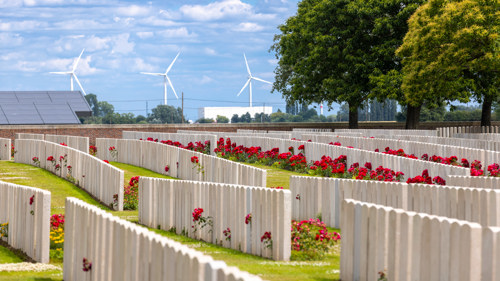
LIJSSENTHOEK MILITARY CEMETERY
This is one of the largest CWGC cemeteries in the world and is worth as special visit for anyone in the area. Throughout the First World War medical facilities were based here to provide care to the sick and wounded. A vast encampment of tents and huts, staffed by thousands of servicemen and women, covered the surrounding fields. Wounded soldiers arrived by stretcher, lorry, light rail and on foot almost continuously day and night, and as the hospitals expanded, the cemetery grew in scale. Medical facilities remained here until 1920, providing care to the personnel who remained behind to clear the battlefields and search for the dead.

MAPLE COPSE CEMETERY
Imagine a moonscape of shattered trees and overlapping shell holes: this was the landscape here, as far as the eye, could see by the end of the First World War. Fighting had raged back and forth over this ground, and while time has healed the scars, this cemetery preserves a witness to the terrible destruction wrought on the landscape here. In 1915 and 1916, a medical unit supporting the troops fighting for the nearby high ground of Mount Sorrel buried some 300 men here, carefully marking and recording each grave. In the years that followed, however, artillery rained down and after the 1918 armistice only a handful of the graves could be found, and even fewer individuals could be identified.
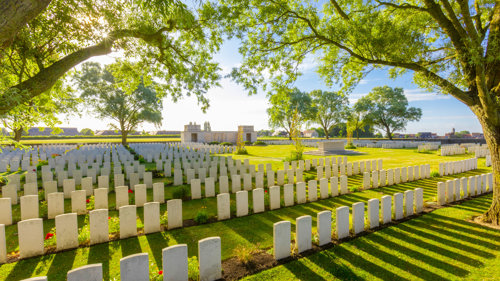
MESSINES RIDGE BRITISH CEMETERY AND N.Z. MEMORIAL
Located on the Messines Ridge, there are stunning views across the landscape from here. This cemetery was begun after the Armistice when remains were brought here from across the battlefields around Messines. At the entrance is the New Zealand Memorial to the Missing. Unveiled in 1924, it was built where the windmill once stood. It is one of seven CWGC memorials on the Western Front listing the names of New Zealand soldiers with no known grave. The cemetery with its unusual shelter building and distinctive memorial were designed by Charles Holden.
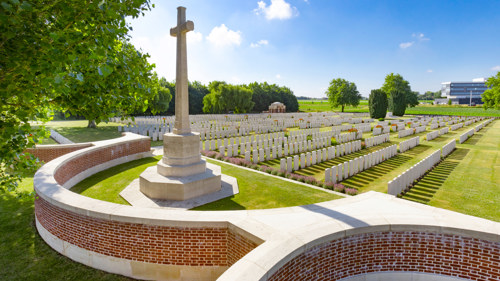
NEW IRISH FARM CEMETERY
There were once dozens of small cemeteries in this area. As the name implies, this was the second of two “Irish Farm” cemeteries. The graves in the original Irish Farm were moved after the 1918 Armistice, leaving only the “new” cemetery. Large and intimidating, with dozens of ordered plots of graves, it can be hard to know where to start here. The architect, Sir Reginald Blomfield, has given you a route to follow. Head through his imposing entrance building and you will see a stone path leading to a raised platform. Here you will find 73 disordered headstones which mark the graves that were here at the end of the war. Standing on the platform beside the Stone of Remembrance, you will look out across a sea of headstones surrounding you on all sides, just as Blomfield and his assistant architect, Arthur Hutton, envisaged.

PASSCHENDAELE NEW BRITISH CEMETERY
There are many ghosts on this part of the battlefield. Those who died were often lost forever in the mud. After the war the area was carefully searched, and this cemetery was begun. You will find many Canadians here, their headstones engraved with the Maple Leaf badge. The cemetery itself was designed by Charles Holden and Wilfred Von Berg. The imposing entrance building is reminiscent of the German block houses which were desperately fought over in this landscape. Inside there are three carefully stepped levels which integrate the cemetery into the gently falling landscape.

PERTH CEMETERY (CHINA WALL)
Located close to the front for most of the war, the cemetery was actually begun by the French Army in 1914. Burials continued to be made here by British and Commonwealth forces in what is today Plot 1, towards the rear of the cemetery, until late October 1917. The story of this place is bigger than the war-time burials, however: post-war re-burials came here from no less than 30 cemeteries, each with its own story to tell.

POELCAPPELLE BRITISH CEMETERY
Nowhere were the battlefields more churned and ploughed by shell fire that here at Poelcappelle. When Commonwealth forces reached this area during 1917’s Third Ypres Offensive, the rain and shelling created a near-impassable swap. Those who died were often lost in the mud, and only after the end of the war was it possible to methodically search this area. Thousands of remains were discovered and reburied here, but due to the nature of the fighting and the passage of time, few could be identified. You will therefore find shockingly few named individuals here despite this being one of the largest Commonwealth cemeteries in the area.

POPERINGHE NEW MILITARY CEMETERY
Known before the war for hop production and brewing, from the autumn of 1914 Poperinghe (now Poperinge) became an important transport hub for supplies and troops destined for the battlefields of the Ypres Salient. Direct rail and road links between Poperinge and Ypres (Ieper), ten kilometres to the east, meant that military infrastructure came to dominate the area: depots and stores for munitions and equipment; casualty clearing stations for medical treatment; camps for thousands of soldiers on their way to and from the front line. Poperinge suffered occasional bombardment but remained relatively unscathed for much of the war and provided many rest and recreation facilities for Allied troops, the most famous of which is Talbot House. During the First Battle of Ypres in the autumn of 1914, what is now known as the Old Military Cemetery at Poperinghe was created and used until the New Military Cemetery was established in June 1915. The cemetery was designed by Sir Reginald Blomfield and Noel Rew. The Stone of Remembrance is raised above the level of the headstones on a platform, while the Cross of Sacrifice is carefully integrated into the design of the entrance feature along with the cemetery shelter buildings.
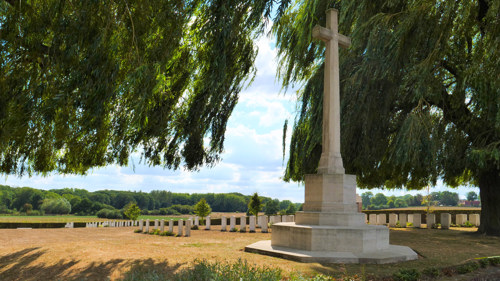
PROWSE POINT MILITARY CEMETERY
This cemetery feels closely connected to the surrounding landscape. It lies on the crest of a gently falling hill and the rows of war-time burials drop away from you as you enter. It was designed by William Cowlishaw who placed the Cross of Sacrifice at the highest point of the cemetery beside a pool. A carefully planted hedge softens the boundary between the cemetery and landscape, and there are views from here out over the dark trees of nearby Ploegsteert Wood, a wood which was here during the war.

RAILWAY DUGOUTS BURIAL GROUND (TRANSPORT FARM)
The hint is in the name--there was a railway here during the war, and when you visit you will see that trains still run along the embankment behind the cemetery. In the Spring of 1915 a medical aid post was established in the buildings that now stand behind the Cross of Sacrifice, known as Transport Farm. The first burials were made here in April 1915, and many more followed after dugouts were made in the railway embankment to expand the medical facilities. Throughout 1916 and 1917 wounded soldiers were brought back from the front line by railway and were cared for in the facilities here. Those who succumbed to their wounds were laid to rest, and the cemetery grew over the years to no particular plan. Today, you will find many disordered rows and isolated original burials here. Located well in range of German artillery, the area suffered much shelling, and many graves were lost, contributing to the disordered nature of this site. After the war, Sir Edwin Lutyens and John Truelove transformed this burial ground, preserving the war-time disorder but smoothing it into a spectacular and fitting place of remembrance.

RAMPARTS CEMETERY, LILLE GATE
This is a remarkable little cemetery perched on the 17th century Vauban-designed defensive wall of Ypres. Standing here during the First World War you would have looked out over the shell-torn battlefields of the salient and witnessed columns of soldiers marching out through the Lille Gate to fight. This was an important gateway to the battlefields throughout the war, and the first burials were made here in 1914 by the French army. The British then established an ambulance station and aid post in the dugouts beneath the walls in early 1915. The wounded arrived here from the battlefields and those who succumbed to their wounds were laid to rest by their comrades.
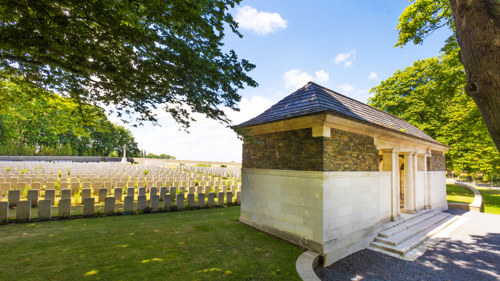
SANCTUARY WOOD CEMETERY
During the first battles fought at Ypres in 1914, a wood here provided shelter for British troops from German observation and artillery fire. It soon became known as ‘Sanctuary Wood’ and in the summer of 1915 several cemeteries were made amongst its trees. The wood and the cemeteries were destroyed a year later by shellfire during the desperate fighting for the nearby high ground of Mount Sorrel. After the 1918 armistice, traces of one of the war-time cemeteries was found. Although records indicated that nearly 140 individuals had been buried at this location, only 49 graves could be found. Almost 10 years after the end of the war, additional burials began here, and from 1927 to 1932 almost 2,000 servicemen were brought here for burial. The original war-time burials form a plot around the Cross of Sacrifice, while the post-war burials were made in a distinctive fan-shaped design created by architects Sir Edwin Lutyens and Noel Rew. This remarkable layout is particularly breath-taking as the curving rows of headstone lie on gently rising ground, giving the effect of an amphitheatre of remembrance.

TYNE COT CEMETERY AND MEMORIAL
After the end of World War 1 the area around Tyne Cot was a wasteland of shell holes as far as the eye could see. Almost nothing remained of the nearby village of Zonnebeke, while Passchendaele village had been obliterated entirely. Tens of thousands of soldiers had died in this small corner of the Ypres Salient. Tyne Cot’s central location near where the fighting had been heaviest made it an ideal site for a large cemetery to be create. By the end of 1921, 11,871 men had been buried, making Tyne Cot the largest CWGC cemetery anywhere in the world. The layout plan for the burials was made in 1919 by John Truelove, who served in France with the London Regiment until he was wounded in action in 1915. After the Commission took over responsibility for Tyne Cot in 1921, plans for the transformation of the cemetery were begun by Truelove and Sir Herbert Baker, one of the Commissions principal architects.

YPRES (MENIN GATE) MEMORIAL TO THE MISSING
Being the most recognizable memorial in the Ypres Salient, and regarded one of the largest memorials to the missing in the world, the Ypres Memorial to the Missing, or most commonly known as the Menin Gate, has stood for almost 100 years on the place where thousands of Commonwealth servicemen marched out of the city towards the Flanders battlefields.
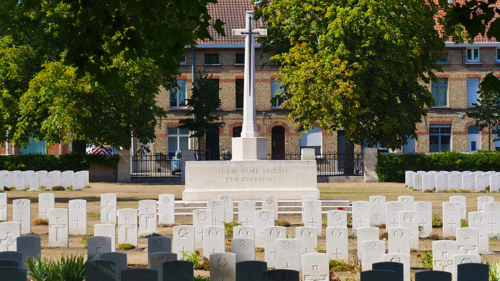
YPRES RESERVOIR CEMETERY
While the fighting raged on the battlefields which surrounded Ypres (now Ieper), the city was alive with activity. Hospitals, headquarters, supply depots, barracks and a multitude of other vital support and auxiliary units called the shell-swept streets home. These people are long gone but some of their fellow service personnel lie at rest here at the heart of the city. Begun by the British army in an area of open land behind the city prison in October 1915, this cemetery was used by the many medical and fighting units that came and went during the war. It grew in a semi structured pattern over the years of conflict, and you can wander the rows of headstones, tracing the course of the fighting based on the dates of death of those at rest here.

YPRES TOWN CEMETERY AND EXTENSION
The British Army arrived at Ypres in the autumn of 1914, and their first burials were made in the civilian cemetery here at that time. Knowing that more space would be required, an extension was made, and service burials continued regularly into both the civilian cemetery and the military extension until late Spring 1915 and then again in 1918. Some 350 more burials were then made in the extension after the Armistice. You will need to explore this large site if you want to find all the graves here - look for the distinctive white CWGC headstones amongst the family markers. It feels like a secret garden of remembrance.

